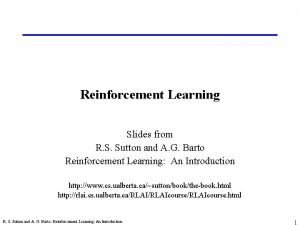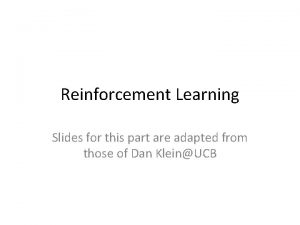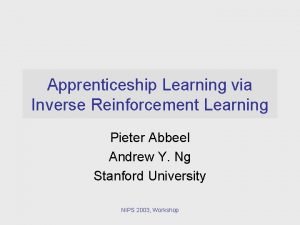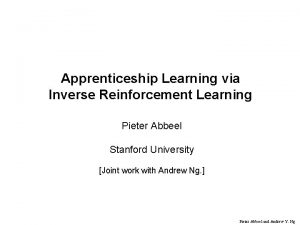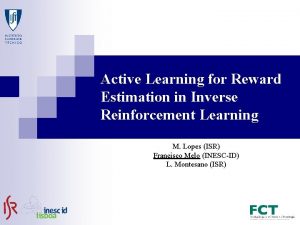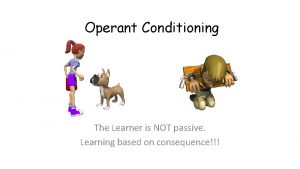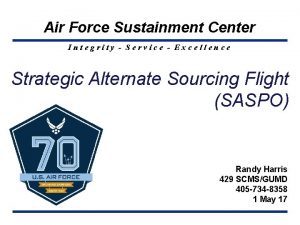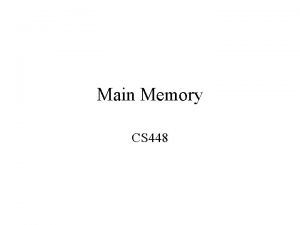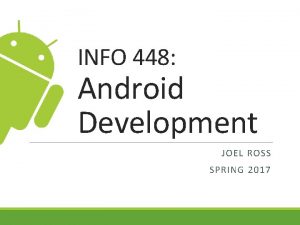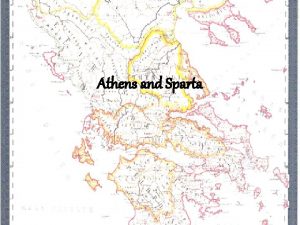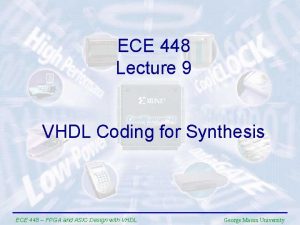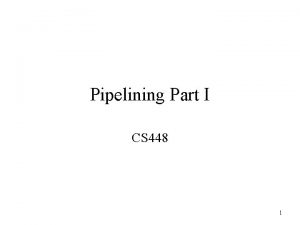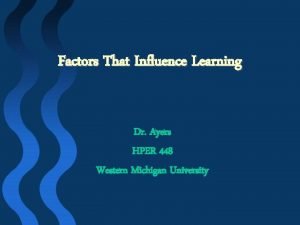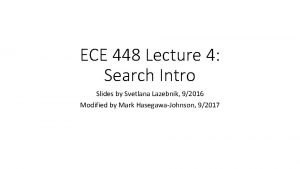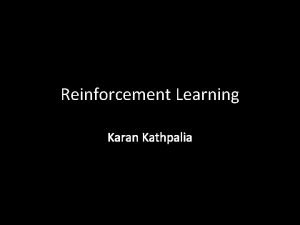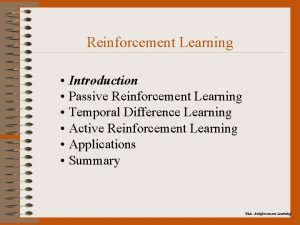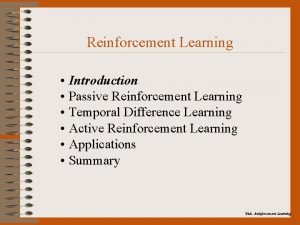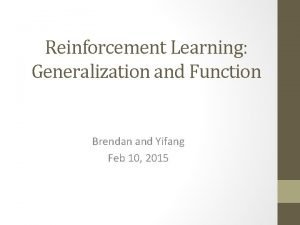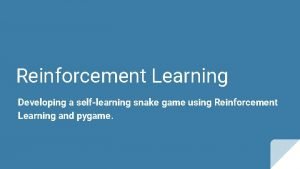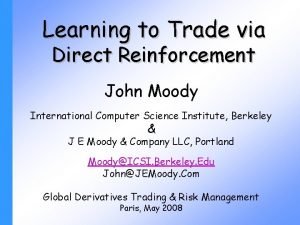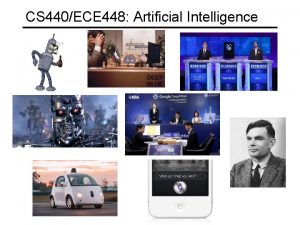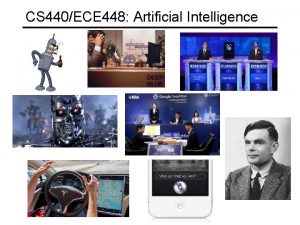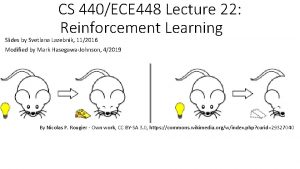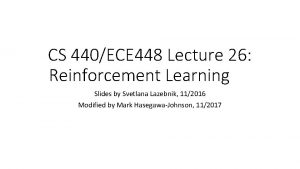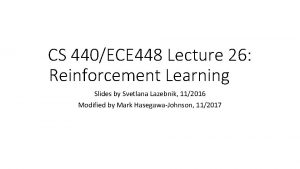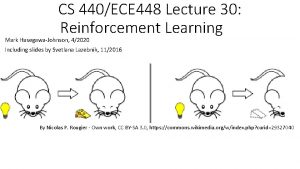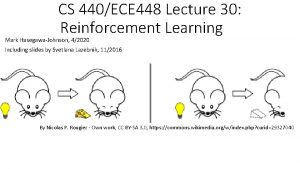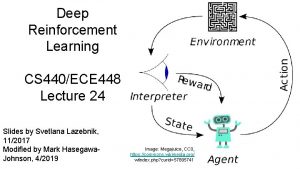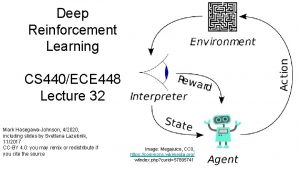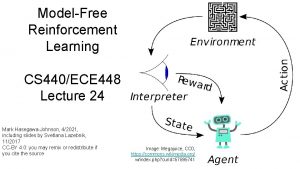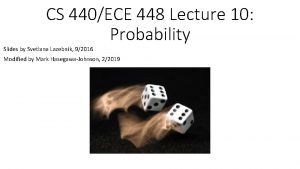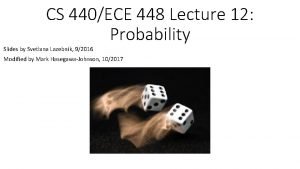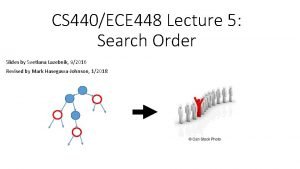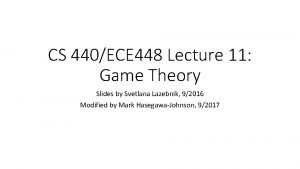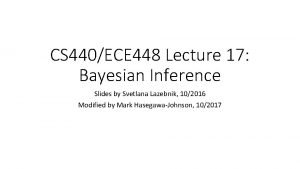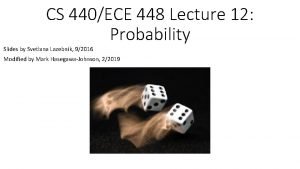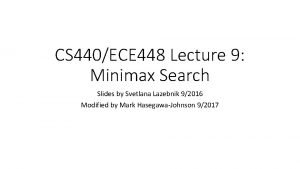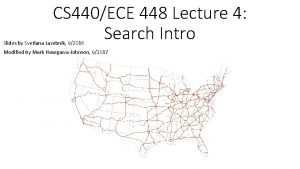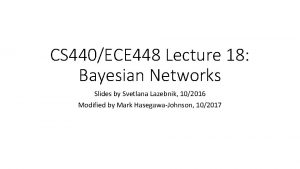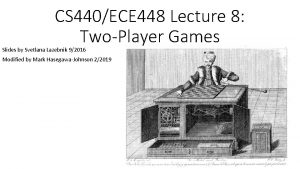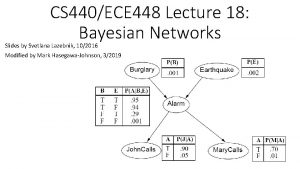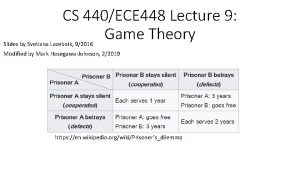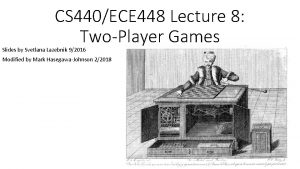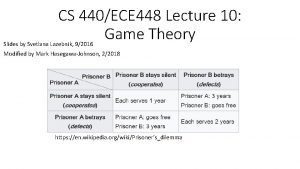CS 440ECE 448 Lecture 21 Reinforcement Learning Slides































- Slides: 31

CS 440/ECE 448 Lecture 21: Reinforcement Learning Slides by Svetlana Lazebnik, 11/2016 Modified by Mark Hasegawa-Johnson, 4/2018 By Nicolas P. Rougier - Own work, CC BY-SA 3. 0, https: //commons. wikimedia. org/w/index. php? curid=29327040

Reinforcement learning • Regular MDP • Given: • Transition model P(s’ | s, a) • Reward function R(s) • Find: • Policy (s) • Reinforcement learning • Transition model and reward function initially unknown • Still need to find the right policy • “Learn by doing”

Reinforcement learning: Basic scheme • In each time step: • • Take some action Observe the outcome of the action: successor state and reward Update some internal representation of the environment and policy If you reach a terminal state, just start over (each pass through the environment is called a trial) • Why is this called reinforcement learning?

Outline • Applications of Reinforcement Learning • Model-Based Reinforcement Learning • Estimate P(s’|s, a) and R(s) • Exploration vs. Exploitation • Model-Free Reinforcement Learning • Q-learning • Temporal Difference Learning • SARSA • Function approximation; policy learning

Applications of reinforcement learning Spoken Dialog Systems (Litman et al. , 2000) Action Greet. S Welcome to NJFun. Please say an activity name or say 'list activities' for a list of activities I know about. Greet. U Welcome to NJFun. How may I help you? Re. Ask 1 S I know about amusement parks, aquariums, cruises, historic sites, museums, parks, theaters, wineries, and zoos. Please say an activity name from this list. Re. Ask 1 M Please tell me the activity type. You can also tell me the location and time.

Applications of reinforcement learning • Learning a fast gait for Aibos Initial gait Learned gait Policy Gradient Reinforcement Learning for Fast Quadrupedal Locomotion Nate Kohl and Peter Stone. IEEE International Conference on Robotics and Automation, 2004.

Applications of reinforcement learning • Stanford autonomous helicopter Pieter Abbeel et al.

Applications of reinforcement learning • Playing Atari with deep reinforcement learning Video V. Mnih et al. , Nature, February 2015

Applications of reinforcement learning • End-to-end training of deep visuomotor policies Video Sergey Levine et al. , Berkeley

Applications of reinforcement learning • Active object localization with deep reinforcement learning J. Caicedo and S. Lazebnik, ICCV 2015

Learning to Translate in Real Time with Neural Machine Translation Graham Neubig, Kyunghyun Cho, Jiatao Gu, Victor O. K. Li Figure 2: Illustration of the proposed framework: at each step, the NMT environment (left) computes a candidate translation. The recurrent agent (right) will the observation including the candidates and send back decisions–READ or WRITE.

Reinforcement learning strategies • Model-based • Learn the model of the MDP (transition probabilities and rewards) and try to solve the MDP concurrently • Model-free • Learn how to act without explicitly learning the transition probabilities P(s’ | s, a) • Q-learning: learn an action-utility function Q(s, a) that tells us the value of doing action a in state s

Outline • Applications of Reinforcement Learning • Model-Based Reinforcement Learning • Estimate P(s’|s, a) and R(s) • Exploration vs. Exploitation • Model-Free Reinforcement Learning • Q-learning • Temporal Difference Learning • SARSA • Function approximation; policy learning

Model-based reinforcement learning • Basic idea: try to learn the model of the MDP (transition probabilities and rewards) and learn how to act (solve the MDP) simultaneously • Learning the model: • Keep track of how many times state s’ follows state s when you take action a and update the transition probability P(s’ | s, a) according to the relative frequencies • Keep track of the rewards R(s) • Learning how to act: • Estimate the utilities U(s) using Bellman’s equations • Choose the action that maximizes expected future utility:

Model-based reinforcement learning • Learning how to act: • Estimate the utilities U(s) using Bellman’s equations • Choose the action that maximizes expected future utility given the model of the environment we’ve experienced through our actions so far: • Is there any problem with this “greedy” approach?

Exploration vs. exploitation • Exploration: take a new action with unknown consequences • Pros: • Get a more accurate model of the environment • Discover higher-reward states than the ones found so far • Cons: • When you’re exploring, you’re not maximizing your utility • Something bad might happen • Exploitation: go with the best strategy found so far • Pros: • Maximize reward as reflected in the current utility estimates • Avoid bad stuff • Cons: • Might also prevent you from discovering the true optimal strategy

Incorporating exploration • Idea: explore more in the beginning, become more and more greedy over time • Standard (“greedy”) selection of optimal action: • Modified strategy: exploration function Number of times we’ve taken action a’ in state s (optimistic reward estimate)

Outline • Applications of Reinforcement Learning • Model-Based Reinforcement Learning • Estimate P(s’|s, a) and R(s) • Exploration vs. Exploitation • Model-Free Reinforcement Learning • Q-learning • Temporal Difference Learning • SARSA • Function approximation; policy learning

Model-free reinforcement learning • Idea: learn how to act without explicitly learning the transition probabilities P(s’ | s, a) • Q-learning: learn an action-utility function Q(s, a) that tells us the value of doing action a in state s • Relationship between Q-values and utilities: • Selecting an action: • Compare with: • With Q-values, don’t need to know the transition model to select the next action

TD Q-learning result Source: Berkeley CS 188

Model-free reinforcement learning • Q-learning: learn an action-utility function Q(s, a) that tells us the value of doing action a in state s • Equilibrium constraint on Q values: • What is the relationship between this constraint and the Bellman equation?

Model-free reinforcement learning • Q-learning: learn an action-utility function Q(s, a) that tells us the value of doing action a in state s • Equilibrium constraint on Q values: • Problem: we don’t know (and don’t want to learn) P(s’ | s, a)

Temporal difference (TD) learning •

Temporal difference (TD) learning • The interpolated form: • The temporal-difference form: • The computationally efficient form (all calculations rolled into one):

Temporal difference (TD) learning • Exploration function Number of times we’ve taken action a’ from state s

Temporal difference (TD) learning • Exploration function Number of times we’ve taken action a’ from state s ? ? ?

Temporal difference (TD) learning • Exploration function Number of times we’ve taken action a’ from state s That’s not necessarily the action we will take next time…

SARSA: State-Action-Reward-State-Action • Exploration function Number of times we’ve taken action a’ from state s’ That is the action we will take next time…

Outline • Applications of Reinforcement Learning • Model-Based Reinforcement Learning • Estimate P(s’|s, a) and R(s) • Exploration vs. Exploitation • Model-Free Reinforcement Learning • Q-learning • Temporal Difference Learning • Function approximation; policy learning

Function approximation • So far, we’ve assumed a lookup table representation for utility function U(s) or action-utility function Q(s, a) • But what if the state space is really large or continuous? • Alternative idea: approximate the utility function, e. g. , as a weighted linear combination of features: • RL algorithms can be modified to estimate these weights • More generally, functions can be nonlinear (e. g. , neural networks) • Recall: features for designing evaluation functions in games • Benefits: • Can handle very large state spaces (games), continuous state spaces (robot control) • Can generalize to previously unseen states

Other techniques • Policy search: instead of getting the Q-values right, you simply need to get their ordering right • Write down the policy as a function of some parameters and adjust the parameters to improve the expected reward • Learning from imitation: instead of an explicit reward function, you have expert demonstrations of the task to learn from
 Reinforcement learning slides
Reinforcement learning slides Reinforcement learning slides
Reinforcement learning slides Ethem alpaydin
Ethem alpaydin Apprenticeship learning via inverse reinforcement learning
Apprenticeship learning via inverse reinforcement learning Apprenticeship learning via inverse reinforcement learning
Apprenticeship learning via inverse reinforcement learning Inverse reinforcement learning
Inverse reinforcement learning Secondary reinforcer definition
Secondary reinforcer definition A small child slides down the four frictionless slides
A small child slides down the four frictionless slides A child is on a playground swing motionless
A child is on a playground swing motionless Principles of economics powerpoint lecture slides
Principles of economics powerpoint lecture slides Business communication lecture slides
Business communication lecture slides 01:640:244 lecture notes - lecture 15: plat, idah, farad
01:640:244 lecture notes - lecture 15: plat, idah, farad 448 scmw
448 scmw Jest głównym dopływem wisły ma 448 km długości
Jest głównym dopływem wisły ma 448 km długości Cs 448
Cs 448 Info 448
Info 448 500 - 448
500 - 448 Ece 448
Ece 448 Ece448
Ece448 Ece 448
Ece 448 Cs 448
Cs 448 Factors of 448
Factors of 448 Ece448
Ece448 Ece 448
Ece 448 Fpga software
Fpga software Cuadro comparativo e-learning y b-learning
Cuadro comparativo e-learning y b-learning Karan kathpalia
Karan kathpalia Passive reinforcement learning example
Passive reinforcement learning example Reinforcement
Reinforcement Bootstrapping machine learning
Bootstrapping machine learning Reinforcement learning snake
Reinforcement learning snake Learning to trade via direct reinforcement
Learning to trade via direct reinforcement
